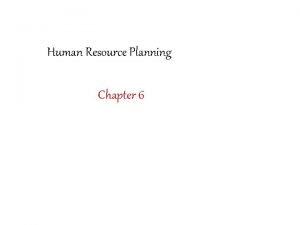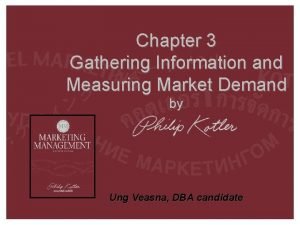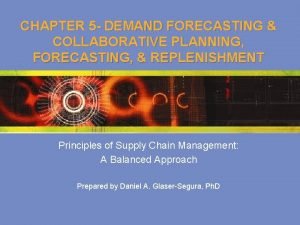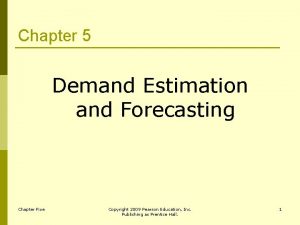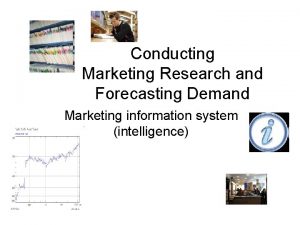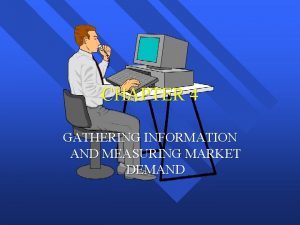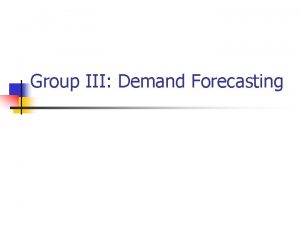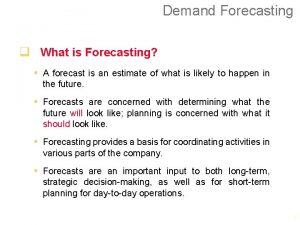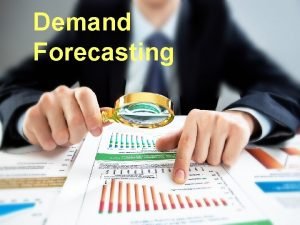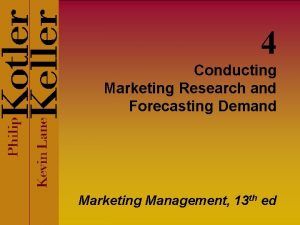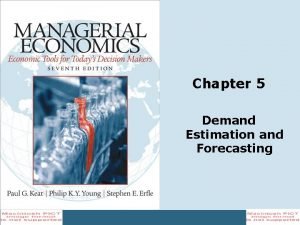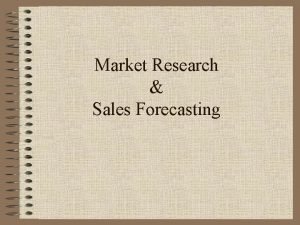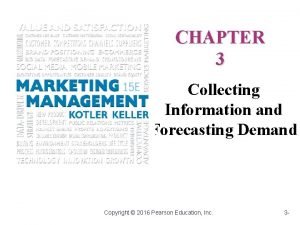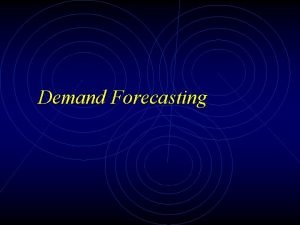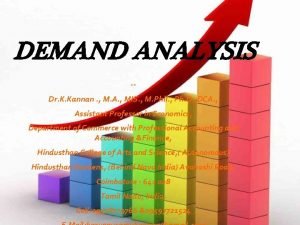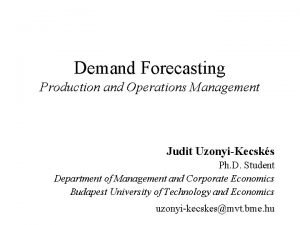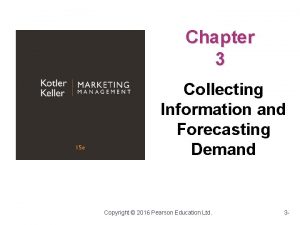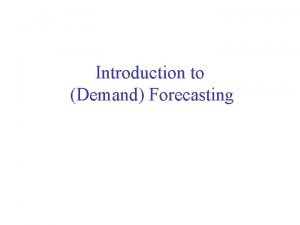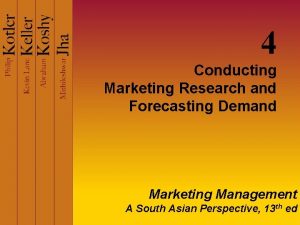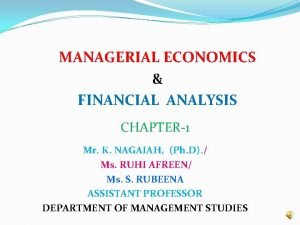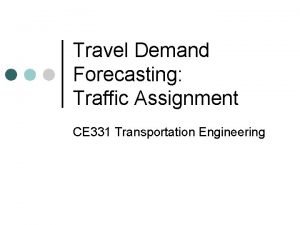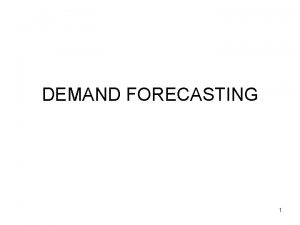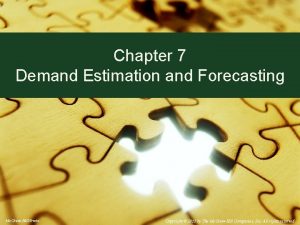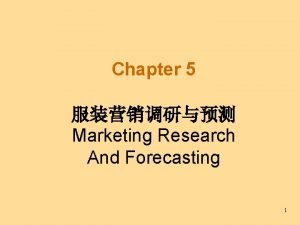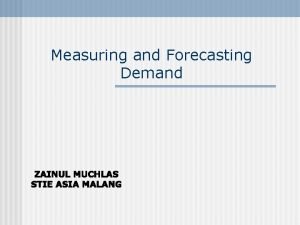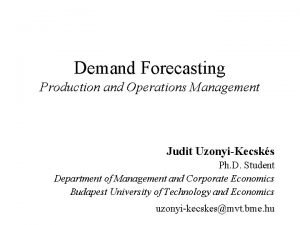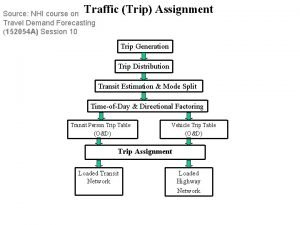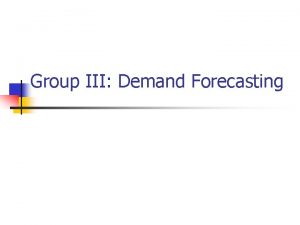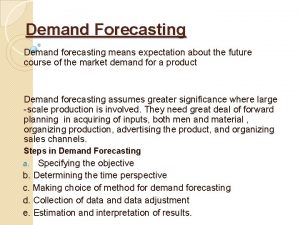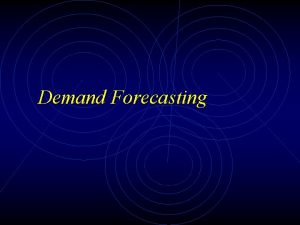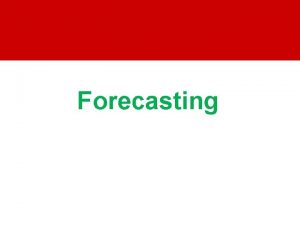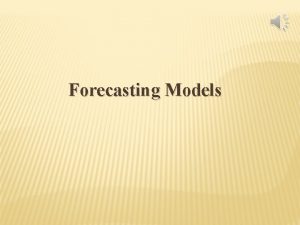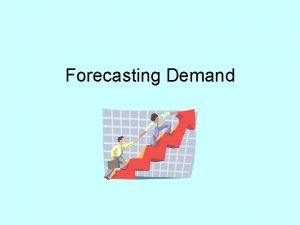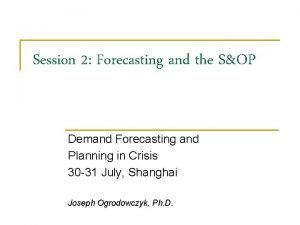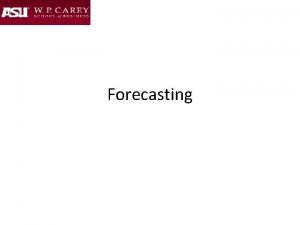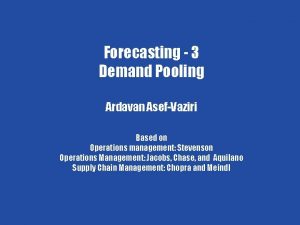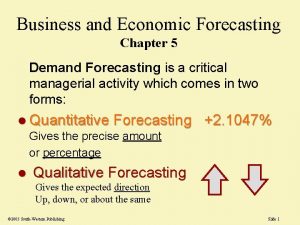Demand Forecasting SO WHAT IS DEMAND FORECASTING 2202021































- Slides: 31

Demand Forecasting

SO WHAT “IS” DEMAND FORECASTING? 2/20/2021

Forecasting customer demand for products and services is a proactive process of determining what products are needed where, when, and in what quantities. Consequently, demand forecasting is a customer–focused activity. Demand forecasting is also the foundation of a company’s entire logistics process. It supports other planning activities such as capacity planning, inventory planning, and even overall business planning.

Characteristics of demand 5 main characters of demand are. Average Demand tends to cluster around a specific level. Trend Demand consistently increases or decreases over time. Seasonality Demand shows peaks and valleys at consistent intervals. These intervals can be hours, days, weeks, months, years, or seasons. Cyclicity Demand gradually increases and decreases over an extended period of time, such as years. Business cycles (recession/expansion) product life cycles influence this component of demand. Elasticity Degree of responsiveness of demand to a corresponding proportionate change in factors effecting it.

TYPES OF FORECASTS PASSIVE FORECASTS Where the factors being forecasted are assumed to be constant over a period of time and changes are ignored. ACTIVE FORECASTS Where factors being forecasted are taken as flexible and are subject to changes.

Why Study forecasting? ØReduces future uncertainties, helps study markets that are dynamic, volatile and competitive ØAllows operating levels to be set to respond to demand variations ØAllows managers to plan personnel, operations of purchasing & finance for better control over wastes inefficiency and conflicts. ØInventory Control-reduces reserves of slack resources to meet uncertain demand ØEffective ØSetting forecasting builds stability in operations. Sales Targets, Pricing policies, establishing controls and incentives

How? THE FORECAST Step 6 Monitor the forecast Step 5 Prepare the forecast Step 4 Gather and analyze data Step 3 Select a forecasting technique Step 2 Establish a time horizon Step 1 Determine purpose of forecast

LEVELS OF FORECASTING AT FIRMS LEVEL AT INDUSTRY LEVEL AT TOTAL MARKET LEVEL

KEY FACTORS FOR SELECTING A RIGHT METHOD TIME PERIOD SHORT TERM 3 -6 Months, Operating Decisions, E. g- Production planning MEDIUM TERM 6 months-2 years, Tactical Decision E. g. - Employment changes LONG TERM Above 2 years, Strategic Decision E. g. - Research and Development

DATA REQUIREMENTS Techniques differ by virtue of how much data is required to successfully employ the technique. Judgmental techniques require little or no data whereas methods such as Time series analysis or Regression models require a large amount of past or historical data.

PURPOSE OF STUDY It means the extent of explanation required from the study. Some techniques are based purely on the pattern of past data and may do quite well at forecasting, whereas many a times these are not useful by themselves since it is difficult to explain the causal factors underlying the forecast.

PATTERN OF DATA STUDIED The pattern of historical data is an important factor to consider. Though most of the times, the major pattern is that of a trend, there also cyclic and seasonal patterns in the data. Certain techniques are best suited for capturing the different patterns in the data. Regression methods incorporates all these variations in data whereas trend analysis methods study these factors individually.

SO , WE KNOW WHAT IT’S ALL ABOUT!!! NOW LETS ANALYSE THE METHODS OF DEMAND FORECASTING.

2 MAIN CATEGORIES MICROECONOMIC METHODS (QUANTITATIVE) - involves the prediction of activity of particular firms, branded products, commodities, markets, and industries. - are much more reliable than macroeconomic methods because the dimensionality of factors is lower and often can easily be incorporated into a model. MACROECONOMIC METHODS (QUALITATIVE) - involves the prediction of economic aggregates such as inflation, unemployment, GDP growth, short-term interest rates, and trade flows. - is very difficult because of the complex interdependencies in the overall economic factors

QUALITATIVE METHODS - SURVEY OF BUYERS INTENSIONS EXPERTS OPINION METHOD DELPHI METHOD MARKET EXPERIMENTATION METHOD - COLLECTIVE OPINIONS METHOD QUANTITATIVE METHODS - TIME SERIES MODELS - TREND ANALYSIS - MOVING AVERAGES METHODS - EXPONENTIAL SMOOTHING - CAUSAL MODELS - REGRESSION MODELS

BUYERS INTENSION SURVEY FEATURES EMPLOYS SAMPLE SURVEY TECHNIQUES FOR GATHERING DATA. Ø DATA IS COLLECTED FROM END USERS OF GOODS - CONSUMER, PRODUCER, MIXED. Ø DATA PORTRAYS BIASES AND PREFERENCES OF CUSTOMERS. Ø IDEAL FOR SHORT AND MEDIUM TERM DEMAND FORECASTING, IS COST EFFECTIVE AND RELIABLE. Ø

ADVANTAGES Ø HELPS IN APPROXIMATING FUTURE REQUIREMENTS EVEN WITHOUT PAST DATA. Ø ACCURATE METHOD AS BUYERS NEEDS AND WANTS ARE CLEARLY IDENTIFIED & CATERED TO. Ø MOST EFFECTIVE WAY OF ASSESSING DEMAND FOR NEW FIRMS

LIMITATIONS ØPeople may not know what they are going to purchase ØThey may report what they want to buy, but not what they are capable of buying ØCustomers may not want to disclose real information ØEffects of derived demand may make forecasting difficult

EXPERTS OPINION METHOD FEATURES PANEL OF EXPERTS IN SAME FIELD WITH EXPERIENCE & WORKING KNOWLEDGE. COMBINES INPUT FROM KEY INFORMATION SOURCES. EXCHANGE OF IDEAS AND CLAIMS. FINAL DECISION IS BASED ON MAJORITY OR CONSENSUS, REACHED FROM EXPERT’S FORECASTS

ADVANTAGES CAN BE UNDERTAKEN EASILY WITHOUT THE USE OF ELABORATE STATISTICAL TOOLS. INCORPORATES A VARIETY OF EXTENSIVE OPINIONS FROM EXPERT IN THE FIELD.

LIMITATIONS JUDGEMENTAL BIASES FOR EXAMPLE ØAvailability heuristic Involves using vivid or accessible events as a basis for the judgment. ØLaw of small numbers People expect information obtained from a small sample to be typical of the larger population

COMPETATIVE BIASES ØOver reliance on personal opinions. ØPossibility of undue influence in certain cases. STATISTICAL INADEQUACY Lack of statistical and quantifiable data or figures to substantiate the forecasts made.

DELPHI METHOD PANEL OF EXPERTS IS SELECTED. ONE CO-ORDINATOR IS CHOSEN BY MEMBERS OF THE JURY ANONYMOUS FORECASTS ARE MADE BY EXPERTS BASED ON A COMMON QUESTIONNAIRE. CO-ORDINATOR RENDERS AN AVERAGE OF ALL FORECASTS MADE TO EACH OF THE MEMBERS.

3 CONSEQUENCES- DIVERSION, CONSENSUS OR NO AGREEMENT. 2 TO 3 CYCLES ARE UNDERTAKEN. CONVERGENCE AND DIVERSION IS ACCEPTABLE. FORECASTS ARE REVISED UNTIL A CONSENSUS IS REACHED BY ALL.

ADVANTAGES ELIMINATES NEED FOR GROUP MEETINGS. ELIMINATES BIASES IN GROUP MEETINGS PARTICIPANTS CAN CHANGE THEIR OPINIONS ANONYMOUSLY.

LIMITATIONS TIME CONSUMING -REACHING A CONSENSUS TAKES A LOT OF TIME. PARTICIPANTS MAY DROP OUT.

MARKET EXPERIMENTATION INVOLVES ACTUAL EXPERIMENTS & SIMULATIONS. COUPONS ARE ISSUED TO FEW SELECT CUSTOMERS. SELECTED CUSTOMERS PURCHASE THE PRODUCTS. PROXIMITY WITH CONSUMERS MAKES INFORMATION COLLECTED RELIABLE. INFORMATION FROM INTERACTIONS BETWEEN SALES PERSONNEL & CUSTOMERS IS USED FORECASTING. BEST USED IF SALES PERSONNEL ARE HIGHLY SPECIALISED AND WELL TRAINED.

ADVANTAGES USES KNOWLEDGE OF THOSE CLOSEST TO THE MARKET. HELPS ESTIMATING ACTUAL POTENTIAL FOR FUTURE SALES. PROVIDES FEEDBACK FOR IMPROVING CUSTOMIZING &

COLLECTIVE OPINIONS METHOD OPINIONS FROM MARKETING & SALES SPECIALISTS ARE COMPILED. 2 TYPES OF TARGETS ESTIMATEDØ AMBITIOUS TARGETS. Ø CONSERVATIVE TARGETS. COMBINES EXPERTISE OF HIGHER LEVEL MANAGEMENT & SALES EXECUTIVES.

LIMITATIONS POWER STRUGGLES MAY OCCUR BETWEEN SPECIALISTS. CONSENSUS MAY NOT BE REACHED IN GOOD TIME. DIFFERENCES AND PREJUDICES IN OPINIONS MAY ALSO EXIST.

BENEFITS OF EFFECTIVE DEMAND FORECASTING HIGHER REVENUES SALES MAXIMIZATION REDUCED INVESTMENTS FOR SAFETY STOCKS IMPROVED PRODUCTION PLANNING EARLY RECOGNITION OF MARKET TRENDS BETTER MARKET POSITIONING IMPROVED CUSTOMER SERVICE LEVELS
 Demand forecasting in managerial economics
Demand forecasting in managerial economics Hr planning meaning
Hr planning meaning Ninety types of demand measurement
Ninety types of demand measurement Collaborative planning forecasting and replenishment
Collaborative planning forecasting and replenishment Demand estimation and forecasting
Demand estimation and forecasting Marketing research and forecasting demand
Marketing research and forecasting demand Gathering information and measuring market demand
Gathering information and measuring market demand Demand forecasting objectives
Demand forecasting objectives Importance of forcasting
Importance of forcasting Forecasting advantages
Forecasting advantages Marketing research and forecasting demand
Marketing research and forecasting demand Demand estimation and forecasting
Demand estimation and forecasting Chain ratio method of demand forecasting
Chain ratio method of demand forecasting Collecting information and forecasting demand
Collecting information and forecasting demand Hotel demand forecasting
Hotel demand forecasting Forecasting demand for autonomous vehicles
Forecasting demand for autonomous vehicles Air travel demand forecasting
Air travel demand forecasting Limitations of demand forecasting
Limitations of demand forecasting Statistical methods of demand forecasting
Statistical methods of demand forecasting Demand forecasting operations management
Demand forecasting operations management Forecasting and demand measurement in marketing
Forecasting and demand measurement in marketing Demand forecasting introduction
Demand forecasting introduction Conducting marketing research and forecasting demand
Conducting marketing research and forecasting demand Statistical methods of demand forecasting
Statistical methods of demand forecasting Travel demand forecasting
Travel demand forecasting Ninety types of demand measurement
Ninety types of demand measurement Simultaneous equation method in demand forecasting
Simultaneous equation method in demand forecasting Demand estimation and forecasting
Demand estimation and forecasting Forecasting and demand measurement in marketing
Forecasting and demand measurement in marketing Current market demand
Current market demand Tracking signal
Tracking signal Demand forecasting
Demand forecasting

